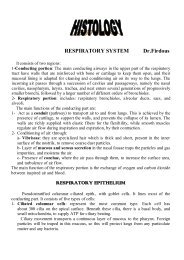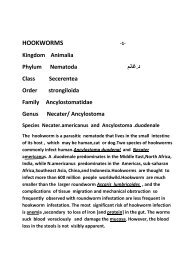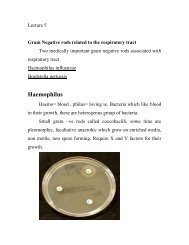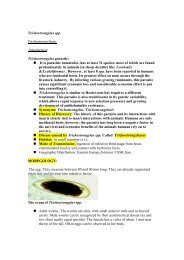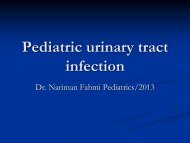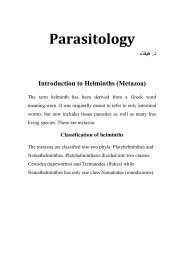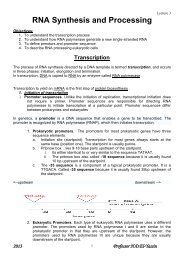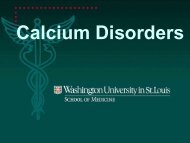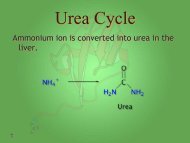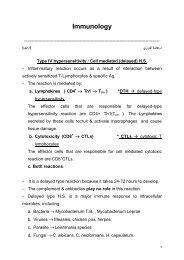THYROID HORMONEs& ANTITHYROID DRUGS
THYROID HORMONEs& ANTITHYROID DRUGS
THYROID HORMONEs& ANTITHYROID DRUGS
Create successful ePaper yourself
Turn your PDF publications into a flip-book with our unique Google optimized e-Paper software.
TRANSPORTT3 & T4 in the plasma are reversibly bound to thyroxine binding globulin (TBG) atransport protein in the blood.PERIPHERAL METABOLISMThe primary pathway of peripheral metabolism is deiodination. Deiodination of T4 mayoccur by monoiodination of the outer ring producing 3,5,3 triiodothyronine (T3).Alternatively deiodination of the inner ring produces 3,3,5 triiodothyronine (reverse T3or rT3) which is inactive.Drugs such as ipodate, beta-blockers & corticosteroids and severe illness or starvationinhibit the 5-deiodinase necessary for the conversion of T4 to T3 resulting in low T3 &high rT3.CONTROL OF <strong>THYROID</strong> FUNCTION Hypothalamic cells secrete thyrotrooin releasing hormone (TRH) into thecapillaries of the pituitary portal system. TRH stimulates the synthesis & release ofthyroid stimulating hormone (TSH). TSH stimulates an adenylyl cyclase-mediatedmechanism in the thyroid gland to increase the synthesis& release of T4 & T3· T4 & T3 act in a negative feedback fashion (mechanism) to block the action ofTRH on the pituitary gland & on the hypothalamus to inhibit the synthesis &release of TRH. In Grave's disease; lymphocytes secrete a TSH receptorstimulating Ab which binds to the TSH receptor. The thyroid gland also regulates its uptake of iodide & thyroid hormone synthesisby intrathyroidal mechanism that are independent of TSH. These mechanismsprimarily related to the level of iodine in the blood. High concentration of iodideinhibits iodide organification, and effect that is useful in the treatment of thyroiddisease. Inadequate iodine intake results in diffuse enlargement of the thyroid(Goitre)MECHANISMS OF ACTION OF T4 & T3T3 is 10 times more potent than T4 and since T4 is converted to T3 in target cells( theliver & kidneys), most of the effect of circulating T4 is probably due to T3.Thyroid hormone binds to receptors in the nucleus that control the expression of genesresponsible for many metabolic processes. These receptors when activated by T3 bind toDNA response elements & control synthesis of RNA which codes for specific proteinsthat mediate the action of thyroid hormones.
The proteins synthesized differ depending on the tissue involved. These proteins includeNa+/K+ ATPase, specific contractile protein in smooth muscles & the heart, enzymesinvolved in lipid metabolism, important developmental components in the brain .... Etc.EFFECTS OF <strong>THYROID</strong> HORMONE Include normal growth & development of the nervous, skeletal, reproductivesystems & control of metabolism of fat, CHO, proteins & also metabolism ofdrugs. Thyroid deprivation in early life results in irreversible mental retardation &dwarfism (congenital cretinism), thyroid hyperactivity results in thyrotoxicosis.Conversely a decrease in thyroid activity results in hypothyroidism (myxedema).PHARMACOKINETICS All of the naturally occurring T4 & T3 exist in Levo form (L-isomers}, the Dextroform of Thyroxine has only 4% of the biological activity of the L-isomer. Thyroxine is well absorbed from the duodenum & ileum when taken orally; oralbioavailability of L- Thyroxine is about 80% absorbed while T3 is almostcompletely absorbed. T4 & T3 can also be given intravenously. In patients with hyperthyroidism, the clearance of T4 & T3 is & the opposite istrue in hypothyroidism. Drugs that induce hepatic microsomal enzymes (e.g.rifampicin phenytoin & Phenobarbital} the metabolism of T4 & T3 & patientsreceiving T4 replacement therapy may require modification ( dosage) tomaintain clinical effectiveness. If TBC binding sites are increased (this is caused by pregnancy, estrogens, oralcontraceptives) there is an initial shift of the hormone from the free to the bondstate & α in the rate of elimination until the normal hormone concentration isrestored thus the total & bound hormone will increase but the concentration of freehormone will remain normal. The reverse occurs when TBG sites are
<strong>THYROID</strong> PREPARATION These preparations are synthetic1. Levothyroxine (is the best which is T4).2. Liothyronine (T3, is faster acting but has shorter half-life & more expensive).3. Liotrix (is a mixture of Thyroxine & liothyronine. It is never required).ANTI- <strong>THYROID</strong> <strong>DRUGS</strong>Reduction of thyroid & hormone effects can be accomplished by agents thatinterfere with the production of thyroid hormones, by agents that modify the tissueresponse to thyroid hormones or by glandular destruction with radiation orsurgery. The anti-thyroid compounds used clinically include the thioamides,iodides & radioactive iodine.THIOAMIDESMethimazole (carbimazole)Propyl thiouracil (PTU) These 2 are the major drugs used in the treatment of thyrotoxicosis {Carbimazolesconverted to methimazole in vivo). The most important effect of these drugs is to block iodination of tyrosine. Alsothese drugs may block the coupling of DIT & MIT. These drugs are given by oral route. Since the synthesis of thyroid hormones ratherthan release is inhibited, the onset of activity of these drudges is usually slowrequiring 3-4 weeks for full effect.
CarbimazolePropyl thiouracil ( PTU)1- More potent given in a single daily Does is 10 times that of Carbimazoledose.given every 6-8 hrs.2-Completely absorbed & readily Rapidly absorbed with a bioavailabilityaccumulated in thyroid gland. of50-80 %3-Excreted in urine but slower than PTU. Excreted in urine within 24 hrs4-Has some immunosuppressive actionleading to decrease in serum TSHreceptor antibodies.No such effect5-Has little effect on conversion of T4 toT3· to T3•It inhibits the peripheral conversion of T46-Crosses placenta.Crosses placenta less readily Preferablein pregnancy7-Sufficient quantity is excreted in breast Not excreted in sufficient quantities tomilk.preclude breast feeding.ADVERSE EFFECTS OF THIOAMIDES occur in 3-12% of treated patients.Most reactions occur early. The most common adverse effect is maculopapular pruriticrash, sometimes accompanied by fever.RARE ADVERSE EFFECTS INCLUDE:1. Urticarial rash.2. Vasculitis.3. Arthralgia.4. A lupus like reaction5. Cholestatic jaundice.6. Lymphadenopathy.7. Hyperprothrombinemia, aplastic anemia & aqranutocytosis the most dangerouscomplication)8. All these adverse effects are reversible.
IODIDE SALTS AND IODINE: Iodide salts inhibit. organification (iodination of tyrosine) and thyroid hormonerelease. These salts also decrease the size & vascularity of the hyperplastic:thyroid gland. Since iodide salts inhibit the release as well as the synthesis of thehormone, their onset of action occurs rapidly within 2-7 days. However theeffect is transient because the thyroid gland escapes from iodide block afterseveral weeks of treatment. Iodide salts are used in thyroid storm(severe thyrotoxicosis) & to prepare thepatient for surgical resections of the hyperactive thyroid. The usual forms of thisdrug are lugol's solution(iodine & potassium iodide) and saturated solution ofpotassium iodide.IODINATED CONTRAST MEDIA (IPODATE): It suppresses the conversion of T4 to T3 via 5 deiodinase in the liver, kidney andother peripheral tissues. Inhibition of hormone release from thyroid gland mayalso play a part. Ipodate has proved very useful in rapidly reducing T3 concentration inthyrotoxicosis (in thyroid storm)RADIOACTIVE IODINE 1 st (ADMINSITERED ORALLY) It is taken up & concentrated in the thyroid gland. A dose large enough toseverely damage the gland can be given without endangering other tissues .An effective dose of. I 131 (single) can produce permanent cure of thyrotoxicosiswithout surgery. I 131 shouldn't be used in pregnancy or nursing mother.β-blockers:Propranolol is used as an effective therapeutic adjuvant in the management ofthyrotoxicosis. Since many of these symptoms mimic these associated withsympathetic stimulation (particularly tachycardia) propranolol ilnhibits 5- deiodinase(the conversion of T4 to T3).



